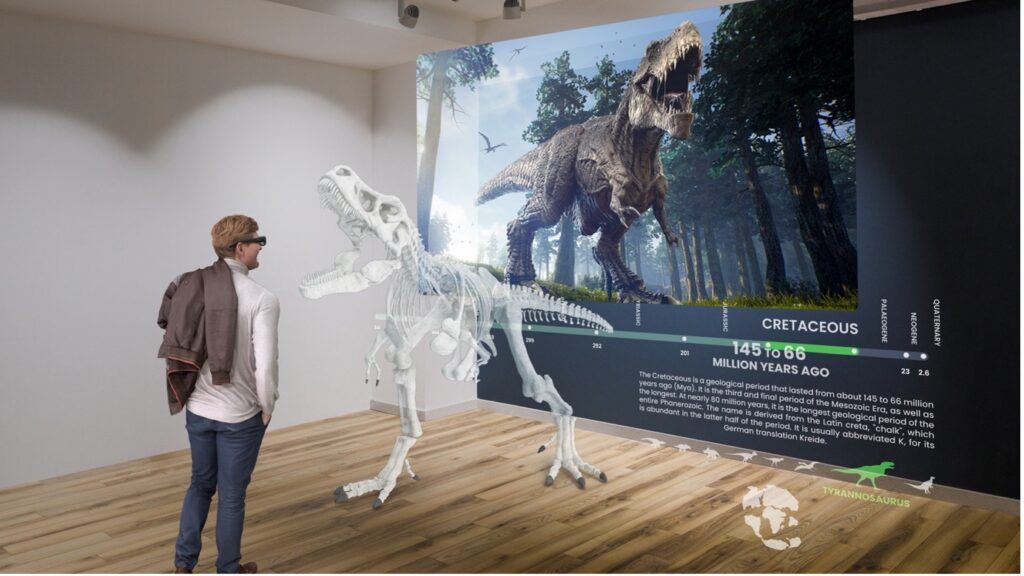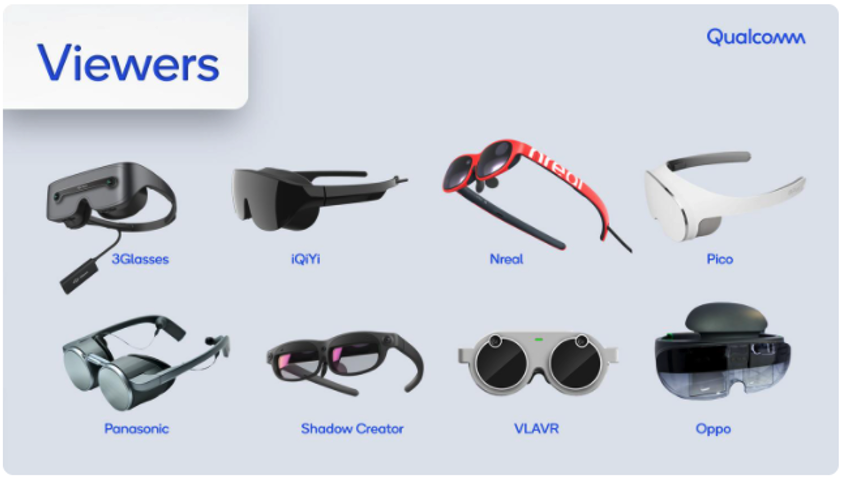
Rapid evolutions in virtual reality (VR) and augmented reality (AR) are paving the way for extended reality (XR), a blending of our physical and digital dimensions. XR merges the real world with the virtual, and the term describes a spectrum of new interactive environments and digital visualisations.
At one end of the spectrum, AR uses digital information on a mobile phone to enhance our real-world environment, and development is being done to integrate AR into desktop platforms. At the other end of the spectrum, VR uses a headset to create simulated experiences that are distinctly separate from the real world. Thus, XR describes the spectrum of reality experiences between VR and AR, integrating digital interactions into our physical world through a range of technologies including mixed reality (MR) glasses and holographic displays.
Once relegated to the realms of fantasy and science fiction (as well as Google Glass early adopters), virtual or holographic displays coexisting in our physical environments are quickly becoming reality. XR can be used in widespread applications, ranging from consumer (gaming, entertainment and education) to commercial (manufacturing, healthcare or retail).
The rise of the XR market has been significantly impacted by the emergence of the COVID-19 pandemic. Most businesses started encouraging remote work, which increased the need for online conferences, meetings, and training.
Furthermore, the adaptability of extended reality platforms in the field of education during the pandemic gave students the ability to better understand pictures and absorb lessons in a more realistic manner at a reduced cost.
In terms of figures, experts estimate that the XR industry will be worth $397.81 billion by 2026. With a market value of approximately $25.84 billion in 2020, this represents an incredible 57.91% compound annual growth rate (CAGR) for the reported period. (Source: XR Today)
Big tech drives for market share

5G technology, with high bandwidth and low latency speeds, has unlocked the doors to mass adoption of MR technology.
Because of the rapid rise of the metaverse, there has been an increased demand for gadgets that can provide consumers with an immersive experience blurring the boundaries between the virtual and real worlds – MR plays a huge role in that. These headsets also fundamentally alter how we can operate, enabling professionals to work from anywhere if in a highly collaborative and mostly visual industry.
Reputable tech companies, like Apple and Samsung, are attempting to enter the market in an effort to secure their position as the top choice. Apple’s MR headgear, which will likely be available in 2023 and cost more than US$2,000, will include functions like FaceTime SharePlay, Apple Maps, and more.
Meanwhile, Meta has been investing heavily in XR for years now with successful product launches. Their latest headset, the Quest 2, costs between US$300 and US$400. Moreover, development is underway on Project Cambria, another MR headset slated for release this year. Project Cambria headsets will show images in high-resolution colour with eye-tracking, owing to more sophisticated cameras, whilst also boasting face tracking as the device can reproduce facial expressions in real-time. Mark Zuckerberg, the founder of Meta, is creating the Cambria headgear with the commercial side of the metaverse in mind.
Another major player in the space is Microsoft which launched the second generation of their MR viewer, the HoloLens2, in late 2019. At a higher price point, it has more appeal for enterprise applications rather than mass consumers. Airbus, Audi, Goodyear, and L’Oréal, just to mention a few, have already accessed the full potential of Microsoft’s ground-breaking mixed reality headgear. Using user-controlled holographic projections, HoloLens allows users to engage in a mixed reality space. Users can touch, hold, and manipulate holograms in ways that seem natural without the necessity of gloves because of the device’s fully articulated hand tracking. But, the real advantage with HoloLens is in collaboration. For example, an engineer in headquarters can collaboratively work with an off-site field specialist in real-time. Those are the use cases where Microsoft HoloLens excels.
We cannot talk about the industry without mentioning early entrant Google which aims to create a lightweight, all-day wearable in the Glass Enterprise Edition 2. Whilst the initial release of Google Glass was a disaster, the repurpose has been successful. Moving from personal to commercial use, with storage of 32GB, blink and wink sensors and an 8MP camera, companies that have adopted it reported that its use has cut production times by streamlining logistics through AR.
Finally, with its ThinkReality A3 headgear, Lenovo holds an intriguing market position that may represent a sweet spot between the completely immersive (and wireless) Microsoft HoloLens 2 and the field-ready Google Glass Enterprise 2.

MR is pushing the boundaries in enterprise applications
MR for commercial use has many benefits – from remote teams being able to collaborate in virtual spaces to large-scale project management. A few companies have dipped their toes into MR applications to test the technology’s use cases in their industry.

Mercedes Benz is trialling Microsoft’s HoloLens to improve the speed and efficiency of servicing their customer’s vehicles. In-field vehicle service technicians can dial into remote specialists for guidance on how to fix vehicles rather than waiting for these specialists to visit in person. Remote specialists review the vehicle through viewers worn by a field technician, guiding the in-field technician through a holographic conference call and other visualisations to help repair vehicles in real-time. The potential time and cost-saving benefits to Mercedes Benz are clear as well as the increased customer satisfaction through an improved speed of service.

Magic Leap, another MR viewer manufacturer, partnered with 3D medical animators Anima Res to launch an MR medical education app called Insight Heart, which will take medical education to a whole new level. Medical students can learn about the human heart by choosing different conditions and learning about their effects on the heart, all through 3D visualisations.
Imagining a world where MR is mainstream
As technology price points are still on the high end, enterprise applications are paving the way in MR adoption. However, consumer applications are not far behind with costs dropping as the technology develops, thanks to renewed interest due to an ever-shifting post-pandemic landscape. Having employees scattered around the globe is the new standard, and XR is supporting a new hybrid way of working.
The work environment is not the only area to be impacted by these social changes. The way that people experience other novel disruptive concepts like the Metaverse is also likely to be significantly impacted by XR.

BT’s Media and Research teams are leading a consortium called 5G Edge-XR to develop mixed reality experiences for live sport. Their goal is to create immersive experiences through your phone or viewers. They envision experiences that bring the stadium into your home or enhance the stadium experience itself by helping you find the nearest toilet, view player stats, and more.

Mojo Vision Lens won the ‘Last Gadget Standing’ best new gadget prize at CES 2021 for its MR contact lens, a discreet option for those not keen on MR glasses. The lens is designed to enhance daily life with information like weather forecasts, restaurant ratings or turn-by-turn directions as you go about your day. Within their latest company report from March 2022, they announced that the newest version of Mojo Lens incorporates numerous industry-first features, such as the world’s smallest and densest dynamic display, low-latency communications, and an eye-controlled user interface.

Although many AR-related technologies are under development, Nreal’s glasses appear to be among the most promising. The Nreal Light and Air glasses, which have unique features like spatial sound, dual microphones, and phone interaction, appear to be some of the more significant contenders in the market. By simply popping on their glasses, users can game, shop or watch their favourite YouTube channels without screen limitations, videos being suspended mid-air for a hands-free viewing experience. Users can either connect Nreal glasses directly to their Android phones or tether them to the Nreal Streaming Box to wirelessly stream content from their phone to their glasses.
Nreal Air AR Glasses are very accessible with a price point of £400, and even more accessible to a wider audience due to offers from mobile network providers like EE, which allows users to spread the cost over several months.

Gaming and fitness used to be mutually exclusive consumer concepts. Wii Sports was one of the first games to shift consumer attitudes and significantly expand the potential for fitness in gaming. That potential only increases as we move deeper into the ever-changing realm of virtual reality. VR fitness games give a whole new meaning to the home workout and make getting in shape far more enjoyable and engaging than watching a video on YouTube. One of the big players in the VR fitness space is FitXR, which is blazing a trail toward immersive, personalised VR Fitness. Their goal is to create a more inclusive, unique, and fun fitness experience that encompasses both the real and virtual worlds. FitXR is currently available on the Oculus Quest and coming soon to Steam and PlayStation VR.
How does MR fit into your future?
MR will be here before we know it. While the technologies are still evolving, now could be the time to start thinking about how it fits into your organisation’s medium to long-term strategy. We’d love to help you plan for your MR future! We have all the tools to help you research, test and design experiences that work. If you would like to discuss how we can help you, get in touch.
Learn more
- Blog: What’s the difference between AR, VR, XR and MR?
- Blog: ‘AR’-commerce – a novel and functional shopping experience
- Blog: AR isn’t mainstream… or is it?




